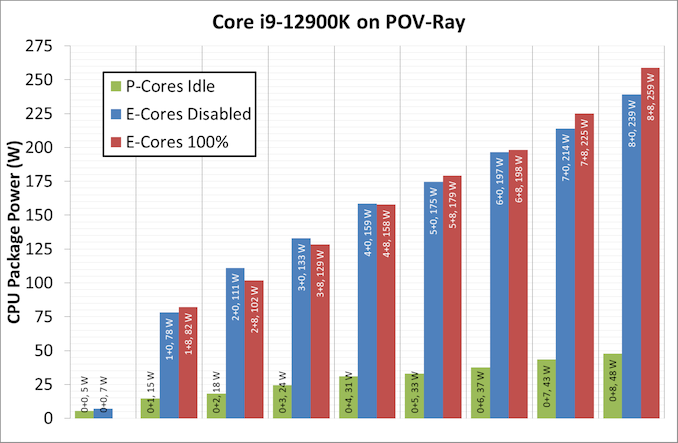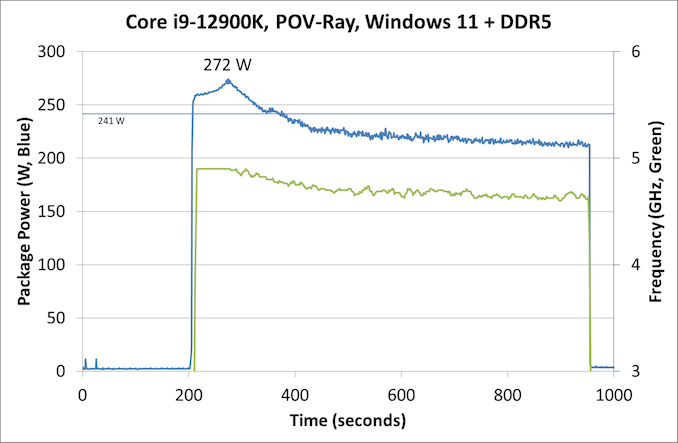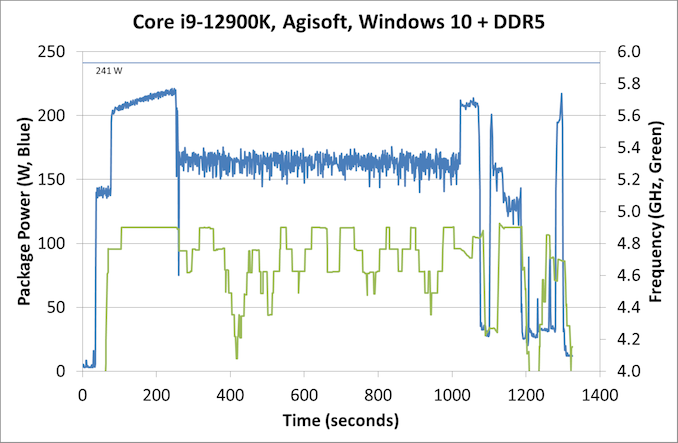The Intel 12th Gen Core i9-12900K Review: Hybrid Performance Brings Hybrid Complexity
by Dr. Ian Cutress & Andrei Frumusanu on November 4, 2021 9:00 AM ESTPower: P-Core vs E-Core, Win10 vs Win11
For Alder Lake, Intel brings two new things into the mix when we start talking about power.
First is what we’ve already talked about, the new P-core and E-core, each with different levels of performance per watt and targeted at different sorts of workloads. While the P-cores are expected to mimic previous generations of Intel processors, the E-cores should offer an interesting look into how low power operation might work on these systems and in future mobile systems.
The second element is how Intel is describing power. Rather than simply quote a ‘TDP’, or Thermal Design Power, Intel has decided (with much rejoicing) to start putting two numbers next to each processor, one for the base processor power and one for maximum turbo processor power, which we’ll call Base and Turbo. The idea is that the Base power mimics the TDP value we had before – it’s the power at which the all-core base frequency is guaranteed to. The Turbo power indicates the highest power level that should be observed in normal power virus (usually defined as something causing 90-95% of the CPU to continually switch) situation. There is usually a weighted time factor that limits how long a processor can remain in its Turbo state for slowly reeling back, but for the K processors Intel has made that time factor effectively infinite – with the right cooling, these processors should be able to use their Turbo power all day, all week, and all year.
So with that in mind, let’s start simply looking at the individual P-cores and E-cores.
Listed in red, in this test, all 8P+8E cores fully loaded (on DDR5), we get a CPU package power of 259 W. The progression from idle to load is steady, although there is a big jump from idle to single core. When one core is loaded, we go from 7 W to 78 W, which is a big 71 W jump. Because this is package power (the output for core power had some issues), this does include firing up the ring, the L3 cache, and the DRAM controller, but even if that makes 20% of the difference, we’re still looking at ~55-60 W enabled for a single core. By comparison, for our single thread SPEC power testing on Linux, we see a more modest 25-30W per core, which we put down to POV-Ray’s instruction density.
By contrast, in green, the E-cores only jump from 5 W to 15 W when a single core is active, and that is the same number as we see on SPEC power testing. Using all the E-cores, at 3.9 GHz, brings the package power up to 48 W total.
It is worth noting that there are differences between the blue bars (P-cores only) and the red bars (all cores, with E-cores loaded all the time), and that sometimes the blue bar consumes more power than the red bar. Our blue bar tests were done with E-cores disabled in the BIOS, which means that there might be more leeway in balancing a workload across a smaller number of cores, allowing for higher power. However as everything ramps up, the advantage swings the other way it seems. It’s a bit odd to see this behavior.
Moving on to individual testing, and here’s a look at a power trace of POV-Ray in Windows 11:
Here we’re seeing a higher spike in power, up to 272 W now, with the system at 4.9 GHz all-core. Interestingly enough, we see a decrease of power through the 241 W Turbo Power limit, and it settles around 225 W, with the reported frequency actually dropping to between 4.7-4.8 GHz instead. Technically this all-core is meant to take into account some of the E-cores, so this might be a case of the workload distributing itself and finding the best performance/power point when it comes to instruction mix, cache mix, and IO requirements. However, it takes a good 3-5 minutes to get there, if that’s the case.
Intrigued by this, I looked at how some of our other tests did between different operating systems. Enter Agisoft:
Between Windows 10 and Windows 11, the traces look near identical. The actual run time was 5 seconds faster on Windows 11 out of 20 minutes, so 0.4% faster, which we would consider run-to-run variation. The peaks and spikes look barely higher in Windows 11, and the frequency trace in Windows 11 looks a little more consistent, but overall they’re practically the same.
For our usual power graphs, we get something like this, and we’ll also add in the AVX-512 numbers from that page:

Compared to Intel’s previous 11th Generation Processor, the Alder Lake Core i9 uses more power during AVX2, but is actually lower in AVX-512. The difficulty of presenting this graph in the future is based on those E-cores; they're more efficient, and as you’ll see in the results later. Even on AVX-512, Alder Lake pulls out a performance lead using 50 W fewer than 11th Gen.
When we compare it to AMD however, with that 142 W PPT limit that AMD has, Intel is often trailing at a 20-70 W deficit when we’re looking at full load efficiency. That being said, Intel is likely going to argue that in mixed workloads, such as two software programs running where something is on the E-cores, it wants to be the more efficient design.














474 Comments
View All Comments
mode_13h - Saturday, November 6, 2021 - link
> Consumers deserve non-broken products that aren’t sold via smoke and mirrors tactics.What's broken, exactly? They said you wouldn't have AVX-512. That someone figured out how to enable it is just bonus.
mode_13h - Saturday, November 6, 2021 - link
Why are you convinced it's so consequential?mode_13h - Saturday, November 6, 2021 - link
Oops, that was a response to:OG> The current situation is inexcusable.
Oxford Guy - Sunday, November 7, 2021 - link
That question is meritless.mode_13h - Sunday, November 7, 2021 - link
If the issue isn't terribly consequential, then why is it inexcusable? The gravity of alleged misconduct usually derives from its impacts.Oxford Guy - Monday, November 8, 2021 - link
I have been suspicious that you’re some sort of IBM AI. Posts like that go a long way toward supporting that suspicion.You were the poster who claimed it’s of little consequence. I was the poster who said it’s inexcusable. Either you’re AI that needs work or your mind is rife with confusion in your quest to impress the community via attempts at domination.
Not a good look, again. Posting your own claims as if they’re mine and using my claims to create a false incompetence situation is a bit better than your pathetic schoolyard taunts. So, perhaps I should praise you for improving the quality of your posts via being merely incompetent — like Intel’s handling of this situation you’re trying to downplay. I shouldn’t make that equivalence, though, as lying to the community in terms of a retail product is worse than any of your parlor tricks.
mode_13h - Tuesday, November 9, 2021 - link
> I have been suspicious that you’re some sort of IBM AI.No way. Their artificial intelligence is no match for my natural stupidity.
:D
> You were the poster who claimed it’s of little consequence.
No, I asked *you* why it's so consequential.
> I was the poster who said it’s inexcusable.
Which sort of implies that it's very consequential. If it's of not, then why would it be inexcusable?
> Either you’re AI that needs work or your mind is rife with confusion in your quest to
> impress the community via attempts at domination.
If you wouldn't waste so much energy posturing and just answer the question, maybe we could actually get somewhere.
I don't honestly care what the community thinks of me. That's the beauty of pseudonymity! I don't even need people to believe I'm somehow affiliated with a prestigious university. Either my points make sense and are well-founded or they aren't. Similarly, I don't care if you're "just" the Oxford garbage collector. If you contribute useful information, then we all win. If you're just trolling, flaming, or pulling the thread into irrelevant tangents, then we all lose.
The main reason I post on here is to share information and to learn. I asked what should be a simple question which you dismissed as meritless, and without explaining why. As usual, only drama ensues, when I try to press the issue. I always want to give people the opportunity to justify their stance, but so often you just look for some way to throw it back in my face.
This kind of crap is extremely low value. I hope you agree.
mode_13h - Saturday, November 6, 2021 - link
> and the sentence about how it could be eliminated in the future.It's true. Intel can disable instructions in microcode updates and in future steppings of the CPU. So, even having the BIOS option is no guarantee.
mode_13h - Saturday, November 6, 2021 - link
> Since the silicon is there, if they can get the scheduler to manage> heterogeneous (P/E) cores there is now no down side with enabling AVX-512.
This will not happen. The OS scheduler cannot compensate for lack of app awareness of the heterogeneous support for AVX-512. I'm sure that was fiercely debated, at Intel, but the performance downsides for naive code (i.e. 99%+ of the AVX-512 code in the wild) would generate too many complaints and negative publicity from the apps where enabling it results in performance & power regressions.
Oxford Guy - Saturday, November 6, 2021 - link
So, Alder Lake is a turkey as a high-end CPU, one that should have never been released? This is because each program has to include Alder Lake AVX-512 support and those that don’t will cause performance regressions?So, Intel designed and released a CPU that it knew wouldn’t be properly supported by Windows 11 — yet the public was sold Windows 11 primarily on the basis of how its nifty new scheduler will support this CPU?
‘The OS scheduler cannot compensate for lack of app awareness of the heterogeneous support for AVX-512’
Is Windows 11 able to support a software utility to disable the low-power cores once booted into Windows or are we restricted to disabling them via BIOS? If the latter is the case then Intel had the responsibility for mandating such a switch for all Alder Lake boards, as part of the basic specification.